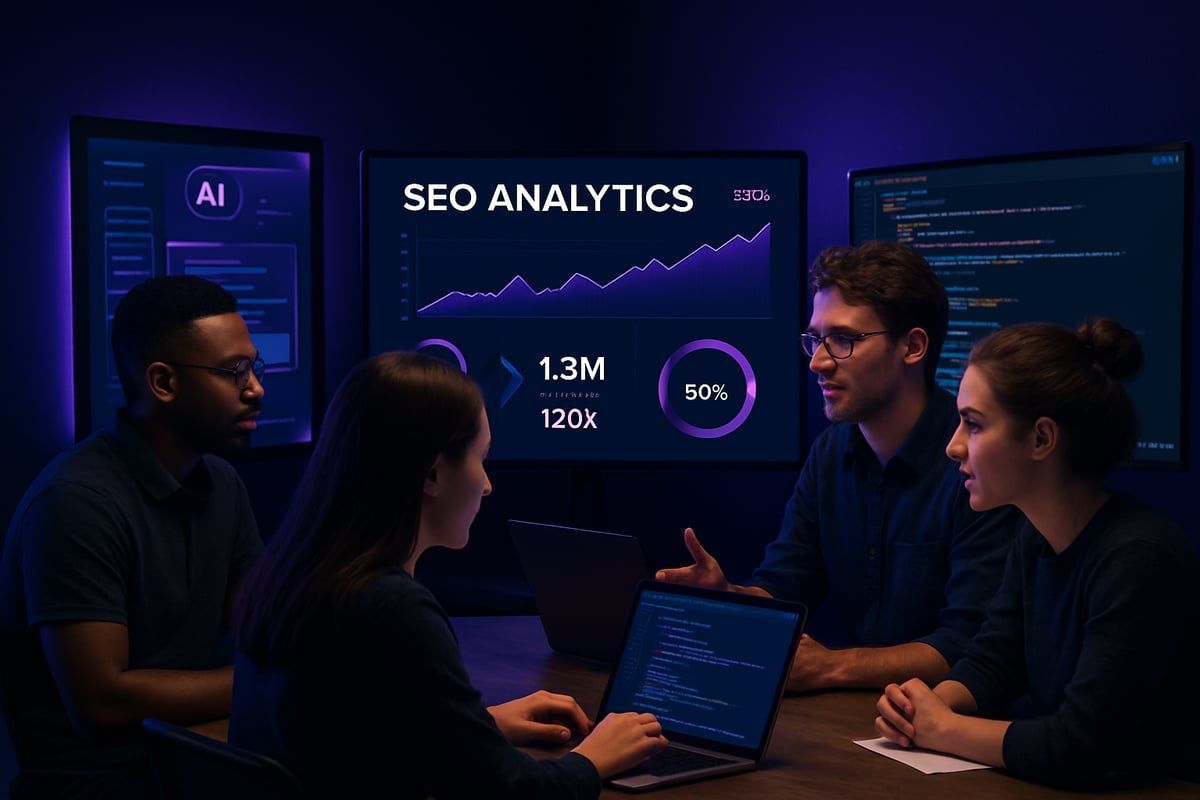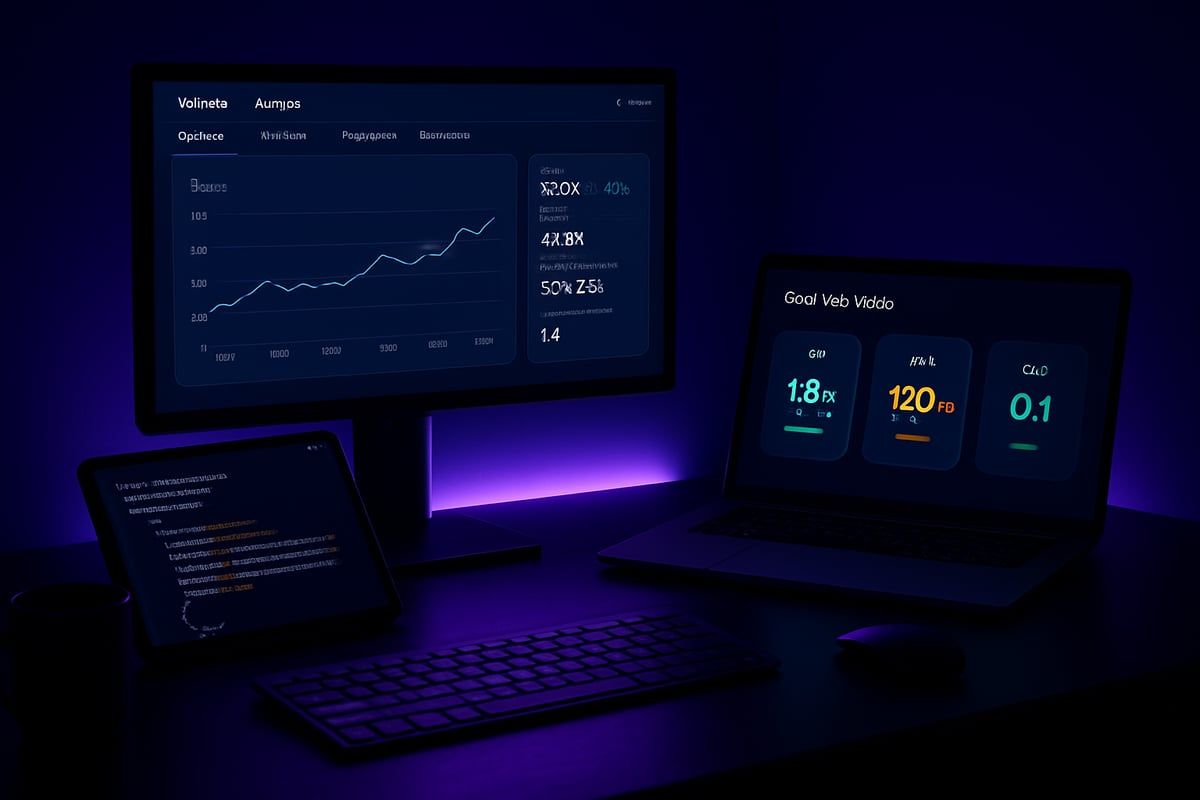Seo And Website Development Guide For 2025 Success
In 2025, the lines between seo and website development are nearly invisible. Success online now demands a seamless blend of technical skill and strategic optimization.
This guide is designed to equip businesses, marketers, and developers with the most current tactics for building SEO-friendly websites. You will learn how to drive more traffic, boost engagement, and increase conversions by integrating practical, up-to-date strategies.
We will explore how SEO has evolved, highlight must-know development trends, and walk you through proven optimization steps. You will also discover technical essentials, content best practices, and how to future-proof your site for lasting results.
Ready to tackle the challenges of 2025 and unlock your website’s full potential? Let’s dive in.
The Evolution of SEO and Website Development in 2025
In 2025, the relationship between SEO and website development is closer than ever. The digital landscape is shaped by advances in artificial intelligence, smarter search algorithms, and rising user expectations. Businesses that succeed are those who intentionally align their SEO and website development efforts from the ground up.

Search Algorithms: AI, User Intent, and Semantic Search
Search engines in 2025 leverage advanced AI to understand user intent more deeply than ever before. Rather than focusing solely on keywords, algorithms interpret context, semantics, and even tone. This evolution means that SEO and website development must work together to deliver content that matches searcher needs, not just search queries.
- AI-driven ranking factors prioritize relevance and engagement.
- Semantic search rewards sites with structured, well-organized content.
- Pages designed for intent-based journeys perform better in results.
The Overlap: Design, Code, and Rankings
The barriers between SEO and website development have faded. Now, design choices and coding practices directly affect rankings. Clean code and intuitive layouts are essential for discovery and engagement.
Consider these impacts:
- Poorly structured code can block search engines from crawling pages.
- UX design influences dwell time, bounce rate, and conversions.
- Cross-functional teams that align SEO and website development see faster results.
A recent Moz and SEMrush study found that 70% of top-ranking sites in 2025 prioritize technical SEO and user experience. Brands that encourage collaboration between development and SEO teams consistently outperform their competition.
Mobile-First, Core Web Vitals, and Google Updates
Mobile-first indexing and Core Web Vitals remain at the heart of successful SEO and website development strategies. Google’s latest updates place even more emphasis on performance and usability.
Key Core Web Vitals in 2025 include:
| Metric | What It Measures | Why It Matters |
|---|---|---|
| Largest Contentful Paint | Loading performance | Faster pages improve ranking |
| First Input Delay | Interactivity | Smoother UX boosts SEO |
| Cumulative Layout Shift | Visual stability | Reduces user frustration |
Sites that meet or exceed these metrics achieve higher visibility and engagement.
Voice and Visual Search Shape Structure
Voice and visual search are no longer futuristic—they are daily habits for millions. Websites now require structure and content that support natural language queries and image-based searches.
- Structured data enables richer search results.
- Conversational content aligns with voice search queries.
- Image optimization supports both visual search and accessibility.
Data, AI Tools, and Accessibility
Automation and AI-driven tools are transforming both SEO and website development. From automatic schema generation to real-time performance monitoring, these technologies help teams adapt faster.
Inclusivity is also a top priority. Accessibility standards, like WCAG 2.2, are now essential for both compliance and ranking. Making sites usable for everyone is not only the right thing to do, it’s a smart SEO strategy.
For those seeking to bridge the gap, resources on SEO best practices for websites provide actionable guidance for integrating technical SEO with modern web development workflows.
The Path Forward
In 2025, the most successful brands recognize that SEO and website development are two sides of the same coin. By embracing AI, prioritizing user experience, and fostering collaboration, businesses can build websites that outrank the competition and deliver lasting results.
Step-by-Step Guide to Building an SEO-Optimized Website
Building a successful site in 2025 requires more than just great design. Today, seo and website development are tightly linked, and every decision you make in one area impacts the other. Let’s break down the process into actionable steps that anyone—marketer, developer, or business owner—can follow.

Planning and Research
Start with a clear roadmap. In 2025, successful seo and website development begin with aligning SEO goals to business objectives. Define what you want to achieve—brand awareness, lead generation, or eCommerce sales.
Next, dive into keyword research. Use tools like SEMrush or Ahrefs to pinpoint high-value keywords that match your audience’s search intent. Analyze your competitors to see what’s working for them, then find gaps you can fill.
Map out user journeys and conversion paths for your site. Think about how visitors discover you, what actions they take, and how they convert. This helps you structure content and navigation for both users and search engines.
For example, a B2B SaaS company might build content around user personas, creating landing pages and blog posts tailored to each stage of the funnel. This approach ensures that seo and website development are working together from the very beginning.
Design and Development Best Practices
Once you have your strategy, focus on execution. Mobile responsiveness is non-negotiable. Design layouts that adapt smoothly to any device, ensuring fast load times and intuitive navigation. Remember, 53% of users leave sites if they wait longer than 3 seconds.
Accessibility matters, too. Follow WCAG 2.2 guidelines so everyone, including users with disabilities, can access your content. Use clear contrasts, alt text for images, and keyboard-friendly navigation.
Keep your code clean and crawlable. Limit plugins to only those you need, as too many can slow your site and create security risks. When you want a head start, explore SEO-optimized website templates that are designed to integrate seo and website development best practices from the ground up.
Table: Key Web Development Features
| Feature | Benefit for SEO |
|---|---|
| Mobile Responsive | Higher rankings, better UX |
| Fast Loading | Lower bounce rates, improved Core Web Vitals |
| Accessibility | Wider reach, ranking signals |
On-Page and Technical SEO Implementation
Now, optimize what’s under the hood. Start by crafting unique title tags, compelling meta descriptions, and well-structured headings for every page. Use keywords naturally, keeping both users and search engines in mind.
Implement structured data (schema markup) to enhance how your site appears in search results. This can boost visibility with rich snippets, especially for products, reviews, and FAQs.
Create XML sitemaps and configure your robots.txt file to guide search engines as they crawl your site. Make sure your site is secure with HTTPS and hosted on a reliable server.
For technical success, seo and website development teams should collaborate on these elements. Use code snippets like this for a basic robots.txt:
User-agent: *
Disallow: /private/
Allow: /
Sitemap: https://yourdomain.com/sitemap.xml
Regularly test your site with tools like Google Search Console to catch and fix issues early.
Content Creation and Optimization
Content is still king, but the rules have evolved. Write for humans first, but always optimize for search engines using E-E-A-T (Experience, Expertise, Authoritativeness, Trustworthiness) principles.
Integrate your keywords naturally into text, images, and videos. Avoid stuffing—focus on relevance and quality. Keep your content fresh with regular audits and updates, which helps maintain rankings as algorithms change.
A practical approach is to revisit older blog posts and update them with new information or better keywords. This keeps your seo and website development efforts evergreen and effective.
For example, many blogs see a traffic boost after refreshing aging content. This proves that ongoing optimization is essential for long-term SEO success.
Technical SEO Essentials for 2025
Technical SEO is the backbone of every high-performing website in 2025. As seo and website development become even more integrated, understanding and implementing these essentials can set your site apart in search rankings and user experience.

Understanding Core Web Vitals
Core Web Vitals remain a major ranking factor for seo and website development. LCP (Largest Contentful Paint), FID (First Input Delay), and CLS (Cumulative Layout Shift) measure site speed and stability. Google’s 2025 updates place even more weight on these metrics.
To improve Core Web Vitals:
- Optimize images using next-gen formats (WebP, AVIF).
- Minimize third-party scripts.
- Prioritize critical CSS and JavaScript.
According to Technical SEO Importance in 2025, sites that excel in technical SEO and Core Web Vitals see higher search visibility and engagement.
Leveraging Advanced Schema Markup
Structured data is now a must-have for seo and website development. Using schema markup—such as Product, FAQ, and local business—helps search engines understand your content and display rich results.
A recent study found 78% of top-ranking sites use advanced schema. For example, a retailer using local business schema can boost visibility in local search and maps.
{
"@context": "https://schema.org",
"@type": "LocalBusiness",
"name": "Tech Store",
"address": {
"@type": "PostalAddress",
"streetAddress": "123 Market St",
"addressLocality": "San Francisco",
"addressRegion": "CA",
"postalCode": "94105"
}
}
Mastering JavaScript SEO
JavaScript is everywhere in modern seo and website development, but it can create indexing challenges. Ensure important content is server-rendered or pre-rendered, making it visible to search engines.
Tips for JavaScript SEO:
- Use dynamic rendering for complex pages.
- Test with Google Search Console’s URL Inspection tool.
- Avoid hiding key links or text behind JS.
Balancing interactivity with crawlability is key for future-proof SEO.
Optimizing for Voice and Visual Search
With more users searching by voice and images, seo and website development must adapt. Voice search favors natural language, FAQs, and concise answers. Visual search requires high-quality, descriptive images with alt text and structured data.
To optimize:
- Add conversational content for voice queries.
- Use image schema for products and how-tos.
- Compress images for fast loading.
Server-side vs. Client-side Rendering
Choosing the right rendering method is crucial for seo and website development. Server-side rendering delivers fully-formed pages to search engines, improving crawlability and initial load speed. Client-side rendering may delay content visibility, impacting rankings.
Use server-side rendering for core pages, and hydrate with client-side interactivity as needed. This hybrid approach supports both SEO and user experience.
Image and Video Optimization
Images and videos are essential for engaging users, but they must be optimized for speed and SEO. Compress files, use responsive images, and add descriptive alt text.
Here’s a quick comparison:
| Optimization Step | Benefit |
|---|---|
| Compress images | Faster load times |
| Use lazy loading | Improved performance |
| Add alt text | Better accessibility |
| Video sitemaps | Enhanced video indexing |
Well-optimized media supports both rankings and accessibility, reinforcing the bond between seo and website development.
Technical SEO in 2025 is all about combining precision, automation, and user-centric design. By mastering these essentials, your site will stand out in a crowded digital landscape.
How AI-Powered Website Builders Like Avantiy Accelerate SEO Success
AI-powered website builders are changing the landscape of seo and website development in 2025. Businesses and entrepreneurs are no longer limited by technical barriers or long development cycles. With these platforms, building a high-performing, search-optimized site is faster and more accessible than ever.

Drag-and-Drop Simplicity Meets SEO Power
Avantiy stands out by blending intuitive drag-and-drop editing with deep seo and website development functionality. Users can choose from customizable templates designed for optimal performance, ensuring their sites look modern and are structured for search engines from the start.
Templates are crafted to be mobile responsive, fast-loading, and accessible. This means businesses can launch beautiful, user-friendly websites that meet Google’s latest standards without writing a single line of code.
Built-In SEO Tools and AI Content Assistant
What really sets Avantiy apart is its suite of built-in SEO tools. Automatic sitemap generation, metadata optimization, and schema integration are all handled behind the scenes, saving time and reducing errors in seo and website development.
Content creation is also streamlined. Avantiy’s AI content assistant for SEO helps users generate optimized copy and even translates content for global reach. This technology ensures every page is aligned with user intent and search engine guidelines, helping sites rank higher and engage more visitors.
Fast, Secure, and Ready for Growth
Avantiy’s hosting infrastructure is designed for speed and security. Sites enjoy best-in-class Core Web Vitals scores, reliable uptime, and HTTPS protection. Plus, seamless integrations with analytics, marketing, and eCommerce tools make it easy to scale as your business grows.
Small businesses, for example, can launch a fully SEO-optimized online store in just a few hours. This rapid deployment is a game-changer in seo and website development, allowing companies to respond quickly to market opportunities.
Real Results: Accelerated Launch and Improved Rankings
The impact is clear. Companies using AI website builders like Avantiy report up to 50 percent faster time-to-launch compared to traditional development. Many also see improved search rankings and increased organic traffic soon after launch.
By combining automation, AI-driven optimization, and user-friendly design, Avantiy is shaping the future of seo and website development. For anyone looking to stay ahead in 2025, embracing these tools is a strategic move.
Future-Proofing Your Website: Strategies for Long-Term SEO and Development Success
Staying ahead in the world of seo and website development requires more than just launching a great site. In 2025, the digital landscape is shifting rapidly, and only those who plan for long-term adaptability will thrive. Search engine algorithms are evolving at lightning speed, user expectations keep rising, and new technologies are emerging constantly.
To future-proof your website, start by monitoring algorithm updates. Search engines are now powered by advanced AI, which means user intent, content quality, and technical health matter more than ever. Regularly review your seo and website development strategies to ensure they align with these changes. Tools that track algorithm shifts, such as Google Search Central and industry blogs, can help you pivot quickly.
Continuous site audits are essential. Schedule technical, content, and UX health checks at least quarterly. Automated tools can uncover issues like broken links, slow-loading pages, or outdated schema. Pair these audits with manual reviews to catch subtle problems.
Scalability is another key factor. Build your website on a modular framework that allows you to add new features, content, or integrations without major overhauls. This approach supports growth and lets you adapt to market needs.
Investing in ongoing content creation and optimization pays off. Search engines reward sites that consistently provide fresh, relevant material. Update existing pages, launch new resources, and experiment with emerging content formats.
Emerging tech like AR, VR, and Web3 is beginning to shape user experiences. Keep an eye on these trends and consider how they could fit into your seo and website development plans. For example, interactive product demos or blockchain-based authentication could set your site apart.
Accessibility and inclusivity are now ranking factors. In 2025, search engines favor sites that meet or exceed accessibility standards. One enterprise recently adapted to new guidelines and maintained its rankings despite a major algorithm update.
Data shows that 80% of marketers believe adaptability is the most important factor for seo and website development success. Regularly leverage analytics and user feedback to identify what works, what doesn’t, and where you can improve.
For a deeper dive into how automation and AI are reshaping this landscape, check the latest insights on AI-Driven SEO and Automation.
Training Teams and Fostering Collaboration
The foundation of long-term seo and website development success is skilled, collaborative teams. In 2025, the boundaries between SEO, development, and content roles are blurring. Cross-functional collaboration ensures every project benefits from diverse expertise.
Begin by encouraging regular knowledge sharing between teams. Host workshops or lunch-and-learns about the latest SEO trends, accessibility standards, or new development tools. Upskilling is crucial, especially as AI, automation, and emerging frameworks become standard in seo and website development.
Integrated workflows make a big difference. Use project management platforms, shared documentation, and clear communication channels to keep everyone aligned. Agencies that adopt integrated, agile workflows have reduced project turnaround times by up to 40 percent.
Consider creating dedicated squads for large initiatives. For example, a team might include a developer, an SEO specialist, a designer, and a content strategist. This structure fosters accountability and enables faster problem-solving.
Encourage experimentation and celebrate small wins. When teams have the autonomy to try new tactics or tools, they are more likely to spot future-proofing opportunities.
Ultimately, strong collaboration and continuous training empower your team to handle the evolving challenges of seo and website development.
Monitoring, Reporting, and Iterating
A future-proof website is never finished. Consistent monitoring, clear reporting, and agile iteration are the hallmarks of modern seo and website development.
Set clear KPIs aligned with your business and SEO goals. These might include organic traffic, conversion rates, Core Web Vitals, or keyword rankings. Use analytics platforms like Google Analytics and Search Console to track progress.
Regular reporting keeps stakeholders in the loop and highlights both wins and areas for improvement. Visual dashboards, tailored to each audience, make data accessible and actionable.
Leverage data insights to refine your approach. If a page’s bounce rate spikes, investigate the cause. If new search interfaces or devices emerge, adapt your layout and content strategy. Staying flexible ensures your seo and website development efforts stay ahead of the curve.
Adopt a schedule for iterative improvements. Monthly sprints or quarterly reviews can help you prioritize updates based on data, not guesswork. This approach has helped companies maintain top rankings even as the digital landscape changes.
For actionable advice on optimizing technical performance, see the latest on
Core Web Vitals 2.0.
You’ve seen how the right blend of SEO strategies and smart website development can set you up for real growth in 2025. If you’re ready to put these insights to work, why not use a platform that takes care of the techy stuff for you? With Avantiy’s AI-powered builder, you can focus on your content and goals while the platform handles SEO, speed, and design. Whether you want to launch a blog, store, or portfolio, there’s a template waiting for you. Ready to take the next step?
Start Building Your Website Today
Start building your new website today
No credit of debit card required start building today




